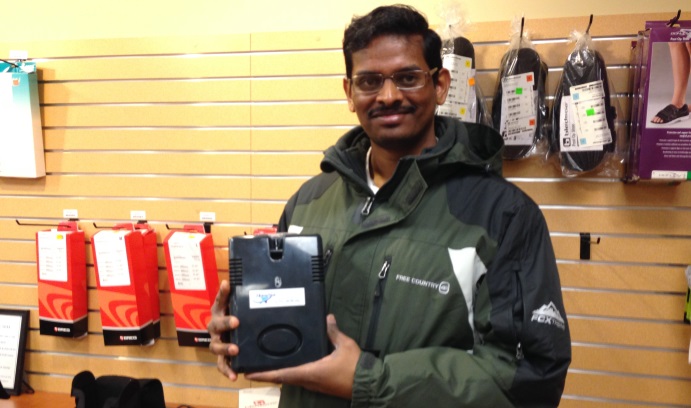A technology transfer success

During an I-Corps training session at the University of California at Berkeley, Vemula Rama Rao gave a presentation on the compact, lightweight medical oxygen concentrator that he helped Profs. Mayuresh Kothare and Shivaji Sircar develop. The research group is one of six at Lehigh that have received I-Corps funding in the past year from the National Science Foundation.
Lehigh tied for fifth place among universities receiving awards in 2014 through a new National Science Foundation program that trains researchers to commercialize their inventions.
Three Lehigh research teams completed entrepreneurship training last year through NSF’s competitive Innovation Corps (I-Corps) program, and three more are scheduled to take the six-week course in February.
According to the National Academy of Inventors, Lehigh and four other universities tied for fifth place among schools whose research teams won I-Corps awards in 2014. The teams receive NSF funding to travel to training sessions, find business mentors and interview potential users of their technology.
Yatin Karpe, associate director of the Office of Technology Transfer, said the showing was impressive.
“For a university of Lehigh’s size to have three teams receive I-Corps funding in two consecutive years,” he said, “testifies to the growing interest of our faculty in entrepreneurship.”
Karpe, who facilitates Lehigh’s involvement in I-Corps, said the program helps researchers take their technology to market by discovering what potential customers want and need.
A clearer idea of a technology's value
Lehigh’s 2014 I-Corps teams represent a variety of research interests. Mayuresh Kothare and Shivaji Sircar, professors of chemical and biomolecular engineering, are developing a smaller, more efficient Medical Oxygen Concentrator (MOC) for persons with Chronic Obstructive Pulmonary Disease (COPD).
Chao Zhou, assistant professor of electrical and computer engineering, develops new imaging technologies for biomedical applications, with a special interest in optical coherence tomography (OCT) and microscopy (OCM). Clay Naito, associate professor of civil and environmental engineering, analyzes the abilities of reinforced and pre-stressed concrete structures to resist the loading forces of explosions, earthquakes and tsunamis.
Zhou, a faculty member in Lehigh’s bioengineering program, said the I-Corps program was “challenging but very rewarding.
“Prior to I-Corps, we developed an ultrahigh speed OCT imaging technology that is more than 20 times faster than the current state-of-the-art commercial devices,” said Zhou.
“During the I-Corps program, we conducted 68 interviews to determine customers’ needs and wants. This gave us a much clearer idea of the competitive advantages of our technology and the value we can bring to OCT end-users and manufacturers.
Zhou’s group identified development tasks and partners while developing a licensing strategy to commercialize their technology.
“One of the key lessons we learned from I-Corps is to treat our initial thoughts—about users’ needs and wants or about market share, for example—as hypotheses, and to test these hypotheses through intensive interviews. We have to be very honest with ourselves and objective when conducting the interviews and analyzing the results. Only then can we know what the market really needs and how our technology can bring value to customers.”
Zhou attended training sessions at I-Corps’ New York City Regional Innovation Node (NYCRIN), Kothare at I-Corps’ Northern California node at the University of California at Berkeley, and Naito at I-Corps’ Southern California node.
“A grueling process”
In February, three more Lehigh research teams will attend training sessions at NYCRIN. These teams are led by Martin P. Harmer, professor of materials science and engineering; by Himanshu Jain, professor of materials science and engineering; and by John Coulter, professor of mechanical engineering and mechanics, and Sabrina Jedlicka, associate professor of materials science and engineering.
I-Corps participants spend the first and seventh weeks training at the I-Corps node. During the five intervening weeks, which they spend at their home universities, they are expected to devote 15-20 hours each week to the program.
Throughout the course, participants attend seminars, webinars and presentations by I-Corps faculty, who often are business professors at node universities. They prepare and give presentations about their technologies. They are expected to interview at least 100 potential users of their product, including consumers, manufacturers, sales people and distributors.
“It’s a very grueling and time-consuming seven weeks,” said Karpe. “But each seven-week session hosts 20-25 teams and provides many opportunities for synergy and for networking. And NSF program directors may attend the first and seventh weeks.”
To apply for the program, researchers must first set up an I-Corps team with a principal investigator, an entrepreneurial lead (usually a postdoctoral research assistant or a graduate student) and a business mentor who understands both the market and the team’s technology.
During their training, I-Corps teams learn how to do a business canvas and a value proposition, how to identify customers and market segments, and how to manage marketing channels, revenue streams and customer relations.
“The I-Corps program,” said Karpe, “helps principal investigators learn whether or not they’re going in the right direction, in regards to commercialization, or whether they need to go back to the lab to improve the viability of their product.”
Researchers also learn to give presentations that focus on the market potential of their technologies.
“People from the venture capital and business worlds watch your presentation and critique it and ask questions,” said Karpe. “It’s like “Shark Tank” each week.”
Research teams that successfully complete the ICORPS program are more likely to win further funding for their projects through NSF’s Small Business Innovation Research (SBIR) and its Partnerships for Innovation (PFI) programs, said Karpe.
Posted on:

